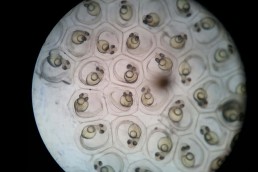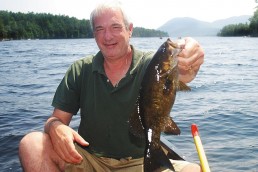Better Perch-rearing Promises Better Perch Fishing
SHARE THIS POST
Ohio’s sportsmen will soon see benefits in many inland lakes that are stocked with yellow perch, due to improved techniques applied at the St. Marys State Fish Hatchery, according to Superintendent Morton Pugh. At recent cool-water hatchery meetings, Ohio’s hatchery managers were able to speak with their counterparts from Wisconsin and South Dakota, who are more experienced with yellow perch production.
As a result, new methods have been learned and applied at St. Marys for the past three years, resulting in higher production numbers.
Three new procedures are primarily responsible for the increased production:
- Instead of relying on yellow perch to spawn on Christmas trees that were placed in the ponds, approximately 1,000 pairs of yellow perch are collected and placed into tanks when the pond water temperature approaches 48 degrees. The brood stocks originated from Lake Erie bloodlines and are kept on site year ‘round to avoid the spread of disease, including Viral Hemorrhagic Septicemia (VHS) from wild Lake Erie populations. Using hormones to stimulate synchronized spawning, their eggs, contained in accordion-like ribbons, are collected and placed into stacked hatching racks called Heath trays or over chicken wire frames.
- Providing a constant source of 54-degree, clean water, they are using four new sand filters to remove iron from their abundant supply of well water, instead of surface water. Previously, they relied on pond or lake water subject to the rise and fall of temperatures common in Ohio’s finicky spring weather, making hatching dates unpredictable. This spring, almost 5.5 million eggs were placed at a density of up to 600 ml of eggs in each of the six trays of the 14 racks. An additional 15.5 million eggs were draped over dozens of chicken wire racks in cement and fiberglass tanks. The 21 million eggs successfully hatched into an estimated 14,482,500 fry that were initially stocked into the targeted lakes, with 12,525,000 going into Grand Lake St. Marys State Park. There were 5,426,000 yellow perch fry retained for growing out into fingerlings. With a conversion rate of yellow perch fry to fingerlings in hatchery ponds running at around 30 percent, the results met this year’s request for 979,500 by fish management for stockings in 2016.
Observations made by biologists showed that in some bodies of water, the saugeye fry had equal survival rates as fish that were stocked as fingerlings.
- By stocking some saugeyes as fry, it allowed the hatchery personnel to switch three ponds from saugeye fingerling to additional yellow perch fingerling production. These changes have resulted in yellow perch fingerling numbers to increase from an average of 678,500 per year stocked into 14 lakes to 979,500 that were stocked into 26 bodies of water, beginning May 19.
Last year, due to favorable results, approximately 1.9 million fingerlings were produced, more than double the goal. An additional 100,000 went to the water at Grand Lake St. Marys State Park, and the other extras were distributed to lakes as dictated by fish administrators in Columbus.
Are you enjoying this post?
You can be among the first to get the latest info on where to go, what to use and how to use it!
Although these popular panfish are mostly stocked into 19 different northwestern Ohio District 2 lakes and reservoirs, they will make it this year into at least one lake in every Wildlife District. They are stocked at a rate of 250 fingerlings per acre, in addition to the fry stocked earlier, plus extra fingerlings when they are available.
With respect to Lake Erie, Fisheries biologists must rely on favorable weather conditions that allow good natural reproduction. Due to the size of Lake Erie, there is not enough hatchery pond space in the state to add enough yellow perch production to be noticeable.
Lake Erie biologists determine harvest quotas to be followed by both sport and commercial fishermen on the U.S. and Canadian sides of the lake to keep catch rates in line with annual reproduction.
John Hageman retired as Manager of Ohio Sea Grant’s Stone Laboratory Biology Station and was formerly an ice guide on Lake Erie at Put-in-Bay, Ohio.
MWO
SHARE THIS POST
Did you enjoy this post?
You can be among the first to get the latest info on where to go, what to use and how to use it!
John Hageman
John Hageman was manager of Stone Laboratory, Ohio Sea Grant's Biology Station at Put-in-Bay, for 25 years and formerly a licensed Lake Erie ice-fishing guide. He is active with the Outdoor Writers of Ohio and several sportsmen's conservation organizations. He may be contacted at hageman.2@osu.edu.




